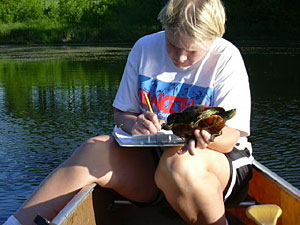|
Audio
Photos
Your Voice
|
New restrictions on turtle trapping
June 30, 2003
 |
| Joanna Schmidt is a student at Minnesota State University Moorhead. She's part of a long-term turtle research project. (MPR Photo/Dan Gunderson) |
Moorhead, Minn. — Joanna Schmidt pushes a canoe into a small slough in rural Clay county. She paddles toward a floating rectangle of plastic pipe. The turtle trap is about four feet long with net in the bottom and a board attached to the side.
"We put a plank on the side and they crawl up to sun themselves and they just fall in," Schmidt says. "It's pretty simple. No mechanics. They do all the work."
Schmidt is a student at Minnesota State University Moorhead. She's part of a long-term turtle research project. This slough is about a quarter-mile across. Along one end, dead, sunbleached trees stick out of the water. It's perfect turtle habitat.
 | |||
"It's warm, lots of food for them, not very many predators, they like it, especially having the dead trees to hang out and sun themselves," Schmidt explains. "This is very typical."
But there are no estimates of how many turtles might live in a slough like this. That's what the researchers are hoping to learn.
There are several turtles in the trap. Most have been caught before. They're identified by small notches in their shells. Schmidt weighs and measures each turtle before gently setting them back in the water.
Minnesota State University Moorhead Biology professor Donna Stockrahm is directing this research project. She says it takes years of research to get meaningful data about turtles. They grow very slowly and they live a long time.
Stockrahm is hoping to learn about rates of turtle mortality, growth rates, and the optimum habitat for turtles. She's seen a puzzling decline in turtle numbers.
"We started this in 2001 and they marked over 250 turtles," Stockrahm says. "Then in 2002 the number just dropped drastically. And there seemed to be fewer turtles around, even turtles you see out sunning themselves on rocks and limbs and dead tree trunks."
 | |||
Stockrahm says she doesn't have an explanation for the decline. She's waiting to see if the trend continues this year.
The Minnesota DNR thinks trapping is one reason turtle populations are down. Tens of thousands of turtles are trapped each year in Minnesota. Rich Baker is animal research coordinator for the DNR's nongame wildlife program. Baker says, it takes years to rebuild a turtle population if adults are removed.
"What we've learned relatively recently is that especially in northern latitudes commercial harvest really isn't sustainable," Baker says. "These populations of slowly maturing species just can't sustain harvest of adults from the population."
Rich Baker says demand for turtles is driven largely by Asian and European markets. Turtles are popular pets, and they's used for medicinal purposes in Asia. Baker says many Asian turtle species are endangered because of over harvest.
"Those markets are turning to North America which is a particularly turtle rich part of the world and the upper midwest which is a particularly turtle rich part of North America," Baker says. "Many of the states in the upper midwest have actually closed turtle harvest completely."
Rich Baker says Minnesota decided to phase out trapping. He says about a dozen people make a living trapping turtles. They'll be allowed to continue but they won't be allowed to take as many turtles.
Only one turtle trapper could be reached to comment on the new rules. He supports the changes, but says he's not seeing fewer turtles.
People who like to eat turtle can still get a license to trap for personal use. But there will be no new commercial turtle trapping licenses. To help meet the demand for turtles, the DNR plans to allow turtle farming. Rules for such operations should be in place later this year.
|
News Headlines
|
Related Subjects
|
